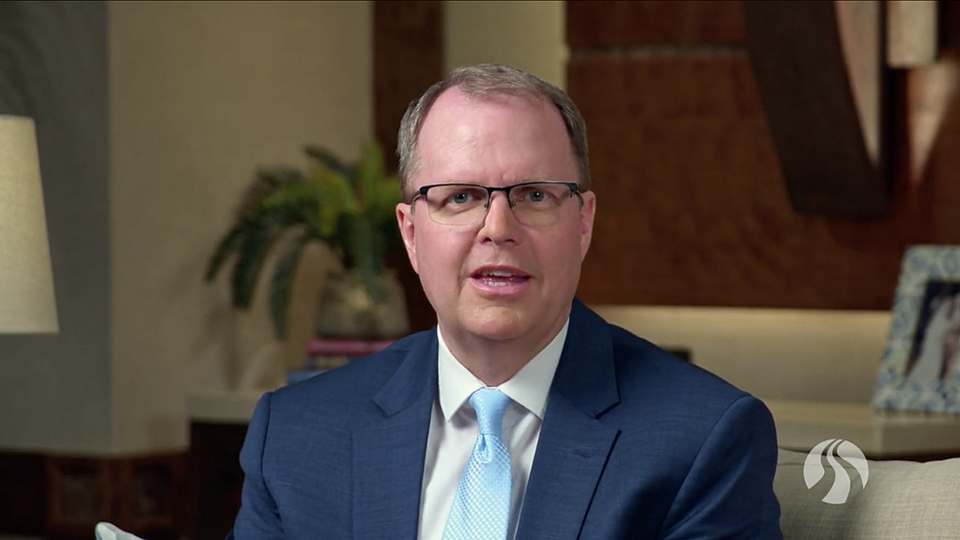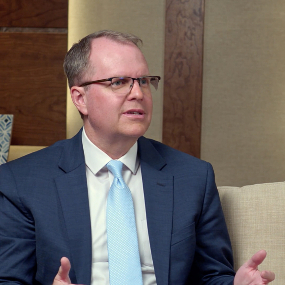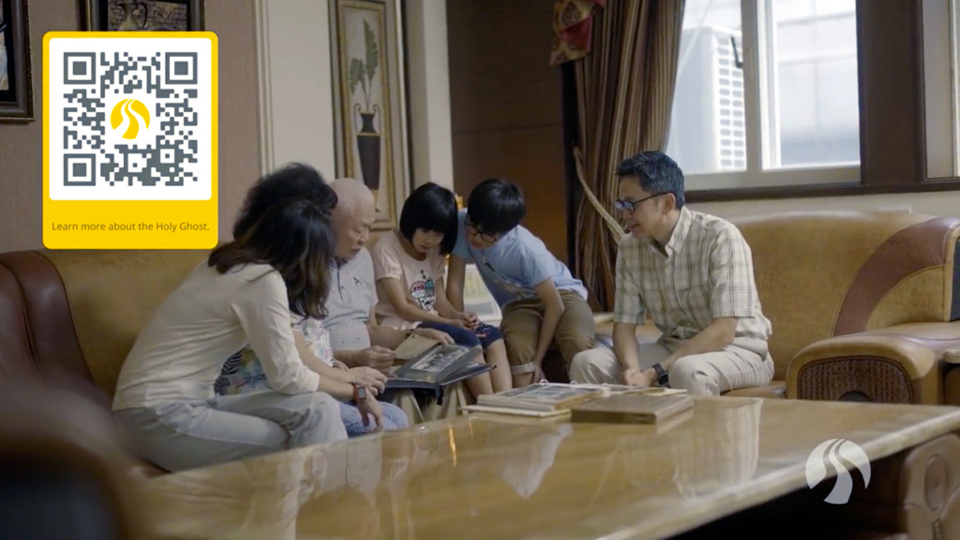
BYU-Pathway-Ashton
BYU-Pathway Worldwide President Brian K. Ashton speaks during a devotional broadcast to students around the world on Tuesday, April 26, 2022. Photo is a screenshot from the broadcast, courtesy of Church News.All rights reserved.
This story appears here courtesy of TheChurchNews.com. It is not for use by other media.
By Mary Richards, Church News
Learning to hear Jesus Christ is about learning to recognize and understand the promptings of the Holy Ghost, BYU-Pathway Worldwide President Brian K. Ashton taught Tuesday, April 26, in the first devotional of a new semester.
President Ashton explained that having the influence of the Holy Ghost “gives us access to the messages, strength, and help that Heavenly Father and Jesus Christ desire to give us.”
He listed 13 ways or roles the Holy Ghost can play:
- The Holy Ghost “is the teacher and witness of all truth” (Elder David A. Bednar, “Seek Learning by Faith”).
- He will “teach [us] all things that are expedient for [us]”(Doctrine and Covenants 75:10, John 14:26) and show us all things that we should do (2 Nephi 32:3, 5).
- The Holy Ghost is a divine source of wisdom and knowledge (Doctrine and Covenants 46:17–18).
- He can help us speak and interpret languages, including helping you with your English language skills (Doctrine and Covenants 46:24–25).
- The Holy Ghost makes us effective teachers (Doctrine and Covenants 42:14).
- He can help us to know what will happen in the future and to be prepared for those events (Doctrine and Covenants 46:22).
- The Holy Ghost is a guide and can protect us from being deceived (Doctrine and Covenants 45:57, Mosiah 2:36).
- He gives us strength to keep God’s commandments (Ezekiel 36:27).
- He can change our heart (Mosiah 5:2).
- He is the source of “love, joy, peace, longsuffering, gentleness, goodness, faith, meekness, [and] temperance” (Galatians 5:22–23).
- The Holy Ghost comforts us (Moroni 8:26; John 14:26; Acts 9:31; Doctrine and Covenants 36:2).
- We are “sanctified by the reception of the Holy Ghost” (3 Nephi 27:20).
- The Holy Ghost makes all our ordinances and covenants binding on earth and in heaven if we live worthily (Doctrine and Covenants 132:7, 18–19).
“These are just a few of the blessings that come into our lives when we have the Holy Ghost with us,” said President Ashton. “Imagine how the Holy Ghost can help you in your studies, your job, your family, and all your righteous endeavors. Imagine what it is like to have the influence of a God, the Holy Ghost, with you potentially at all times.”
President Ashton spoke about the difference between the power of the Holy Ghost versus having the gift of the Holy Ghost. Anyone can have the power of the Holy Ghost come upon them from time to time, he said. But the constant companionship of the Holy Ghost comes to those who are baptized and have the gift of the Holy Ghost conferred upon them by one holding the proper priesthood authority.

BYU-Pathway-Ashton
BYU-Pathway Worldwide President Brian K. Ashton speaks during a devotional broadcast to students around the world on Tuesday, April 26, 2022. Photo is a screenshot from the broadcast, courtesy of Church News.All rights reserved.“Thus, if we want to have the Holy Ghost all the time, we must apply what the scriptures call ‘the doctrine of Christ’ in our lives,” said President Ashton, meaning exercise faith in Jesus Christ, repent, be baptized, receive the gift of the Holy Ghost and endure to the end.
“We endure to the end by trusting God and striving to develop more faith, continuing to repent, partaking of the sacrament regularly, receiving the Holy Ghost to a greater degree, and continuing to progress to become more like Jesus Christ,” said President Ashton.
He talked about how when he was a mission president, he asked the missionaries to describe how they knew when God was speaking to them — and many had more than one way.Most said they had thoughts come into their minds that they recognized came form the Lord. Some had dreams, some got a “burning in their bosom.” Some described a still, small voice. Others had to move forward in faith believing that they were making a correct decision and a confirmation would come later.
No matter how He speaks to us, the Holy Ghost will only prompt us to do good,” said President Ashton.
He said it takes effort, practice and time to learn how to fully recognize and understand messages coming from the Holy Ghost. On his mission in Peru as a young man, he determined that whenever he had a feeling to do something that seemed to be good, he would act on it. He came to realize the subtle but distinguishable difference between his own thoughts and those that came from God. And he grew in his ability and confidence to recognize and understand promptings from the Holy Ghost.

BYU-Pathway-Ashton
A QR code is displayed during BYU-Pathway Worldwide devotional on April 26, 2022, linking to President Brian K. Ashton’s personal list of scriptures that help him understand how God speaks to him. Photo is a screenshot from the broadcast, courtesy of Church News. 2022 by Intellectual Reserve, Inc. All rights reserved.In conclusion, President Ashton pleaded with the BYU-Pathway students to seek to “hear Him.” He promised that as they did so, they would find greater joy and peace in their lives.

